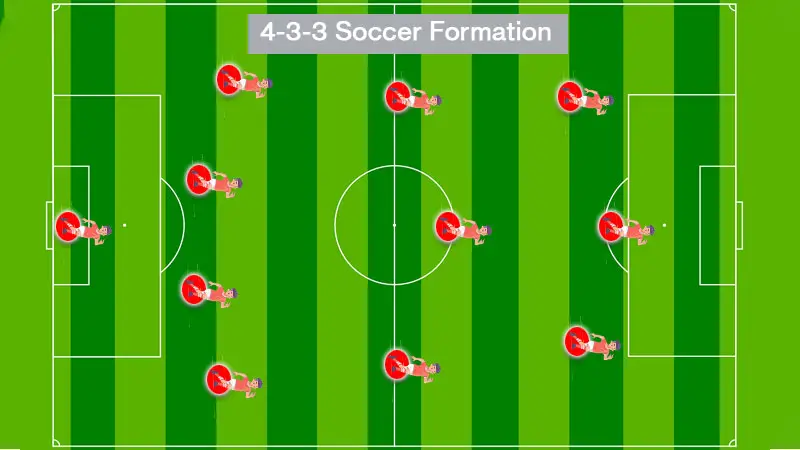The 4-3-3 soccer formation has revolutionized the way teams approach both offense and defense on the field. This versatile setup, popularized by legendary teams like Barcelona and the Dutch national team, offers a balanced blend of attacking prowess and defensive solidity.
By positioning four defenders, three midfielders, and three forwards, it creates multiple layers of play that can adapt to various game situations.
Coaches and players favor the 4-3-3 formation for its flexibility and ability to control the game’s tempo. The three midfielders can dominate possession, while the three forwards provide constant attacking threats.
This formation not only enhances the team’s overall dynamics but also allows individual players to showcase their skills in specific roles.
Whether you’re a soccer enthusiast or a budding coach, understanding the intricacies of the 4-3-3 formation can elevate your appreciation of the beautiful game.
Mastering the 4-3-3 Soccer Formation
The 4-3-3 soccer formation positions players to maintain a balance between attack and defense. Coaches favor this formation for its flexibility and the ability to control match tempo.
Basics and Origin
Dutch coach Rinus Michels popularized the 4-3-3 formation in the 1970s. Initially used by Ajax and subsequently adopted by the Dutch national team, this setup focuses on ball possession and short passes.
In the 2000s, clubs like Barcelona renewed interest in the formation, emphasizing its effectiveness in modern soccer.
Defenders
Four players form the backline, consisting of two center-backs and two full-backs. Center-backs protect the penalty area while full-backs support wing play.
Midfielders
Three players comprise the midfield unit, typically including a central defensive midfielder and two central or attacking midfielders. The defensive midfielder shields the backline, and the other two contribute to both defense and attack.
Forwards
Three forwards make up the attacking line, with a central striker and two wingers. The striker focuses on scoring, while the wingers stretch the opponent’s defense and assist in creating goal opportunities.
Tactical Strengths of the 4-3-3 Formation
The 4-3-3 formation offers several tactical strengths, making it a favorite among many coaches and teams. Its structure allows for a dynamic approach to both offense and defense.
Utilizing Width in Attack
The 4-3-3 formation excels at using width to stretch the opponent’s defense. Wingers play a crucial role in this strategy by hugging the touchlines and creating space for midfielders and forwards.
For instance, wingers like Lionel Messi and Cristiano Ronaldo have demonstrated how effective this can be. By keeping wide positions, wingers can exploit the spaces left by full-backs, leading to more goal-scoring opportunities.
Enhancing Midfield Control
Midfield control becomes more manageable with three central midfielders. Each player can take on specific roles such as a defensive midfielder, a box-to-box midfielder, or an attacking midfielder. Famous examples include players like Xavi Hernandez and Andrea Pirlo.
Their ability to control the tempo and distribute the ball has been pivotal in teams that use the 4-3-3 formation effectively. Midfielders can also support both the attack and defense, making quick transitions easier and more fluid.
Common Weaknesses and Counter Tactics
Despite its advantages, the 4-3-3 formation has specific vulnerabilities that opponents can exploit.
Challenges in Defense
The 4-3-3 formation often leaves gaps in defense when wingers push forward if the team loses possession. This exposes the full-backs to counterattacks, particularly if the central defenders can’t cover quickly.
Additionally, the formation’s reliance on a single defensive midfielder places significant pressure on this player to break up opposition attacks. Teams with swift, counter-attacking players can find space between the lines, making rapid advances difficult to manage.
Strategies to Overcome Weaknesses
Teams can counter 4-3-3 formation weaknesses by implementing a few key strategies. Defensive midfielders should maintain position and avoid overcommitting to the attack to minimize exposure during transitions.
Wingers can track back more consistently to support the defensive line when possession is lost. Instructing full-backs to stay slightly deeper can help counteract opposition pace.
Employing a high defensive line can also compress space, reducing gaps and limiting the opponent’s ability to exploit speed in counterattacks.
4 3 3 Formation Numbers, Roles, and Type of Players
The 4-3-3 formation requires specific player roles to leverage its strengths and balance. Each position demands distinct skills and responsibilities.
Goalkeeper
The goalkeeper in a 4-3-3 formation needs to be confident with ball distribution. Accurate passing is critical, as they initiate build-up play from the back. They should also excel in one-on-one situations since gaps may appear during offensive pushes.
Central Defenders
Central defenders in this formation require strong tactical awareness. They should anticipate counterattacks when wingers advance. High physicality and aerial ability are crucial, as they often contest headers and shield the goal from direct threats.
Fullbacks
Fullbacks must balance their roles between defense and attack. They provide width by overlapping with wingers, creating additional offensive options. High stamina and speed are essential, as they frequently sprint up and down the flank to support both ends of the field.
Midfielders
The three central midfielders consist of a defensive midfielder and two central or attacking midfielders. The defensive midfielder needs strong tackling skills and positional sense to protect the defense.
Central midfielders should excel in ball control, passing, and pressing to disrupt the opposition and sustain possession. Creativity and vision also benefit the attacking midfielders in creating scoring opportunities.
Forwards
The forward line comprises a central striker and two wingers. The striker must have excellent finishing skills and hold-up play to retain possession under pressure. Wingers need pace, dribbling skills, and the ability to deliver accurate crosses.
They should also contribute defensively to prevent opposition breaks, maintaining the formation’s balance.
Frequently Asked Questions
What skills are critical for midfielders in a 4-3-3 formation?
Midfielders in a 4-3-3 formation require good ball control, passing accuracy, stamina, and tactical awareness. The defensive midfielder should excel in tackling and positioning, the controller in setting game tempo, and the creator in linking the play and assisting forwards.
How does the role of fullbacks change in a 4-3-3 formation?
Fullbacks in a 4-3-3 formation have dual roles. Offensively, they provide width and support wingers by overlapping. Defensively, they track back to maintain team shape and cover opposition wingers.
What player qualities are essential for the 4-3-3 forward line?
Forwards in a 4-3-3 formation need speed, technical skills, and good positioning. Wingers should be adept at dribbling and crossing, while the central forward, or striker, should possess excellent finishing abilities and the capability to press high.
Why is a single defensive midfielder crucial in a 4-3-3 formation?
A single defensive midfielder is crucial because they act as the primary shield for the defense, interrupt opposition attacks, and initiate the team’s transition from defense to attack.
How does maintaining width in attack benefit a 4-3-3 formation?
Maintaining width in attack stretches the opposition defense, creating space for central players. It makes it difficult for opponents to defend compactly and provides more crossing opportunities for the attacking team.
Conclusion
The 4-3-3 formation offers a harmonious blend of offensive and defensive capabilities making it a versatile choice for many teams.
Its ability to exploit width and control the midfield is unmatched though it requires disciplined and strategically aware players to mitigate its vulnerabilities.
Each position within this formation has unique demands ensuring that every player’s role is crucial to the overall success on the field.
By understanding and optimizing these roles teams can fully harness the potential of the 4-3-3 formation to achieve a well-balanced and effective gameplay strategy.
Furthermore, coaches should focus on developing chemistry between the midfield and forward players to create seamless transitions and dynamic attacks. Proper training and communication are essential for players to adapt and excel within this structure.








Brice Petersen